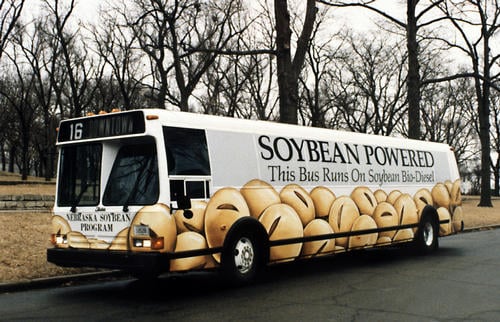When taken into consideration that the purchase of fuel and the taxes paid on that fuel, maintenance (e.g. oil and filter changes), insurance, registration, smog testing (biennial or every two years, typically) and parking to name a few, car ownership isn’t exactly an inexpensive proposition. Also there are associated social and environmental costs to consider. What years ago may have represented a small share of household income, today, for most Americans, transportation eats up a significant amount of family budgets.
Something like 8,800 miles is what Americans on a per-capita basis are driving on average each year. Even though this is laudable considering at one time average per-person U.S. driving topped 10,000 miles annually, the fact is aggregate yearly driving in America has surpassed 3.2 trillion miles.
What that means is that, year-to-year, ever more people are taking to the roads in ever more vehicles. The number of registered cars, light trucks, buses and trucks in the United States totals approximately 263 million.
On top of this, automobiles in America are only getting about an average 22-to-23 miles per gallon where their fuel-economy or fuel-efficiency ratings are concerned. That’s it.
What this translates to is that the average stateside motor vehicle consumes on a per-annum basis, 382.6 to 400 gallons of fuel to travel those 8,800 or so miles.
Factor in the price of gasoline at say $2.65 per gallon, and the cost to drive all 8,800 yearly mean miles averages out to anywhere from $1,013.91 to $1,060.00 annually. And, that’s just for driving that distance alone – nothing else.
To put matters in context, using the arbitrary figure of 200 million drivers, with each driver using as many as 400 gallons of gasoline over a year’s time, the amount of gasoline consumed by the vehicles driven by all of those 200 million drivers would be enormous! How enormous? Eighty-billion-gallons-of-gasoline enormous: to be exact.
Throw in motor vehicle wear-and-tear and the damage caused to roadway infrastructure and congestion and delay and one can fast comprehend the scope of the situation.
The costs of not driving and using public transportation instead
In its Jun. 8, 2018 “June Transit Savings Report: Soaring Gas Prices Take Transit Savings to Highest Level of the Year” press release, the American Public Transportation Association emphasizes: “The average annual savings is $10,160 for a person who switches his or her daily commute from driving to taking public transportation, according to the American Public Transportation Association’s (APTA) June Transit Savings Report. … Individuals who ride public transportation instead of driving can save, on average, more than $847 per month.
“These savings are based on the cost of commuting by public transportation compared to the cost of owning and driving a vehicle. Driving costs include the June 6, 2018, national average gas price ($2.94 per gallon, as reported by AAA) and the national unreserved monthly parking rate.
“The national average for a monthly unreserved parking space in a downtown business district is $166.26, according to the latest report of the Colliers International Parking Rate Study. Over the course of a year, parking costs for a vehicle can amount to an average of $1,995.”
So, say, 50 percent of the driving population switched modes and rode transit buses instead. Think how much gasoline could be saved just from the sheer numbers of motorists switching modes.
Using that same arbitrary 200 million-person figure referenced above, if half instead become transit-bus users, that 80-billion-gallons-of-gasoline-consumption-rate in a year could also be cut in half – a savings of 40 billion gallons.

More importantly is the savings gained through fewer motor vehicle tailpipe-released emissions entering the atmosphere. Those savings would be even greater if biodiesel-fuel-powered, hybrid or zero-polluting buses are utilized.
What’s more, for those roadways so affected, with that kind of reduction in automobile use those would be less encumbered.
And, that’s something truly hard to put a price on!
Dream on soy boy! The buses are filled with homeless and drug addicts in LA and probably most other metropolitan centers that are run by the Democrats.. They are not safe nor convenient, especially for women.
Interesting that the share of transit in New York City weighs in at 9 percent with lesser percentages in U.S. cities elsewhere. Those aren’t really strong numbers. Denver’s transit has lost riders. From what I understand this is mostly attributed to driver shortages and it is affecting both transit bus and light-rail transit there.
That said, if the buses went where people needed to go and were frequent enough my sense is more people would use them. Not to be overlooked is transit ridership and transit service in Seattle, Washington. It is one of the American transit success stories. Transit fares much better abroad. Think Hong Kong, Rome, Tokyo and Toronto.
And, here’s the kicker: Bus rapid transit ridership in Ottawa was so high, eventually buses could not keep up with demand. The bus system was replaced with light-rail transit which, as a matter of fact, just opened late last year as a replacement. You might want to read: “Performance enhancement – Part 3: Transit buses to the rescue?” here: https://alankandel.scienceblog.com/2013/03/14/performance-enhancement-part-3-transit-buses-to-the-rescue